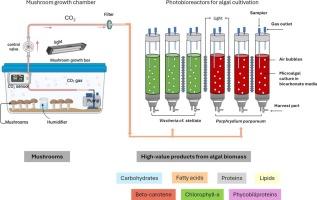A circular bioprocess for integrated microalgal CO₂ capture and valorisation in mushroom cultivation
IF 4.5
2区 生物学
Q1 BIOTECHNOLOGY & APPLIED MICROBIOLOGY
Algal Research-Biomass Biofuels and Bioproducts
Pub Date : 2025-09-01
DOI:10.1016/j.algal.2025.104293
引用次数: 0
Abstract
Mushroom farming is a rapidly expanding industry, yet conventional cultivation practices contribute significantly to carbon dioxide (CO2) emissions, highlighting the need for sustainable carbon mitigation strategies. This study presents the first bicarbonate-based microalgal carbon capture process using in situ CO₂ emissions from mushroom cultivation, enabling circular bioresource utilisation. Oyster mushrooms were grown in a controlled growth chamber, and the emitted CO₂ was converted into a bicarbonate-enriched medium to cultivate two microalgal species: Vischeria cf. stellata and Porphyridium purpureum. Culture pH was optimised at small scale, with optimal pH (pH 7) selected for scale-up in 8 L photobioreactors. P. purpureum consistently outperformed V. stellata in mushroom-derived bicarbonate media, achieving over 85 % inorganic carbon removal, threefold higher biomass yield, and significantly increased lipid, protein, and phycobiliprotein (phycoerythrin and phycocyanin) accumulation. The enhanced pigment production suggests an adaptive response to high salinity and alkalinity. In contrast, V. stellata showed higher productivity in synthetic bicarbonate media and experienced growth inhibition and extended lag phases in mushroom-based media at scale, likely due to salt stress. This work demonstrates the feasibility of scalable, circular carbon capture and utilisation within mushroom farming and highlights the critical role of algal strain selection and stress tolerance for optimising biomass productivity and high-value product generation.

蘑菇栽培中集成微藻co2捕获和增值的循环生物过程
蘑菇种植是一个迅速发展的产业,然而传统的种植方法对二氧化碳(CO2)排放有很大贡献,这突出了可持续的碳减缓战略的必要性。本研究提出了第一个基于碳酸氢盐的微藻碳捕集工艺,利用蘑菇栽培的原位二氧化碳排放,实现生物资源的循环利用。在可控的生长室内培养平菇,将排放的二氧化碳转化为碳酸氢盐富集的培养基,培养两种微藻:Vischeria cf. stellata和Porphyridium purpureum。在小范围内优化培养pH,在8l光生物反应器中选择最佳pH (pH 7)进行放大。P. purpureum在蘑菇来源的碳酸氢盐培养基中的表现始终优于V. stellata,其无机碳去除率超过85%,生物量产量高出三倍,并显著增加了脂质、蛋白质和藻胆蛋白(藻红蛋白和藻蓝蛋白)的积累。色素产量的增加表明了对高盐度和高碱度的适应性反应。相比之下,星状弧菌在合成碳酸氢盐培养基中表现出更高的生产力,在蘑菇培养基中经历了大规模的生长抑制和延迟期延长,可能是由于盐胁迫。这项工作证明了在蘑菇养殖中可扩展的、循环的碳捕获和利用的可行性,并强调了藻类菌株选择和应力耐受性对优化生物量生产力和高价值产品产生的关键作用。
本文章由计算机程序翻译,如有差异,请以英文原文为准。
求助全文
约1分钟内获得全文
求助全文
来源期刊

Algal Research-Biomass Biofuels and Bioproducts
BIOTECHNOLOGY & APPLIED MICROBIOLOGY-
CiteScore
9.40
自引率
7.80%
发文量
332
期刊介绍:
Algal Research is an international phycology journal covering all areas of emerging technologies in algae biology, biomass production, cultivation, harvesting, extraction, bioproducts, biorefinery, engineering, and econometrics. Algae is defined to include cyanobacteria, microalgae, and protists and symbionts of interest in biotechnology. The journal publishes original research and reviews for the following scope: algal biology, including but not exclusive to: phylogeny, biodiversity, molecular traits, metabolic regulation, and genetic engineering, algal cultivation, e.g. phototrophic systems, heterotrophic systems, and mixotrophic systems, algal harvesting and extraction systems, biotechnology to convert algal biomass and components into biofuels and bioproducts, e.g., nutraceuticals, pharmaceuticals, animal feed, plastics, etc. algal products and their economic assessment
 求助内容:
求助内容: 应助结果提醒方式:
应助结果提醒方式:


